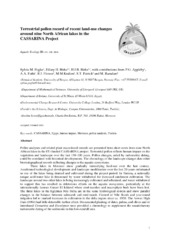Terrestrial pollen record of recent land-use changes around nine North African lakes in the CASSARINA Project
Birks, Hilary H.; Birks, Harry John Betteley; Appleby, P. G.; Fathi, Adel A.; Flower, Roger J.; Kraïem, Mohammed M.; Patrick, Simon T.; Ramdani, Mohammed
Peer reviewed, Journal article
Permanent lenke
https://hdl.handle.net/1956/2514Utgivelsesdato
2001Metadata
Vis full innførselSamlinger
Originalversjon
https://doi.org/10.1023/a:1011988127627Sammendrag
Pollen analyses and related plant macrofossil records are presented from short cores from nine North African lakes in the EU-funded CASSARINA project. Terrestrial pollen reflects human impact on the vegetation and landscape over the last 150–100 years. Pollen changes, aided by radiometric dating, could be correlated with historical developments. The chronology of the landscape changes date other biostratigraphical records reflecting changes in the aquatic ecosystems. Three lakes in Morocco show gradually intensifying land-use over the last century. Accelerated technological development and landscape modification over the last 20 years culminated in one of the lakes being drained and cultivated during the project period. In Tunisia, a nationally unique acid-water lake is threatened by water withdrawal for increased catchment cultivation. The landscape around two other lakes is being increasingly cultivated and urbanised, and water withdrawal to support this has resulted in deleterious effects on the aquatic ecosystems, particularly at the internationally famous Garaet El Ichkeul where reed-marshes and macrophyte beds have been lost. The three lakes in the Egyptian Nile Delta are in the same hydrological system and show parallel changes in the balance between saltmarsh and reed-marsh. Control of Nile floods and year-round irrigation led to marked increases in cultivation in the delta region since ca. 1920. The Aswan High Dam (1964) had little detectable further effect. Documented planting of dates, palms, and olives and of introduced Casuarina and Eucalyptus trees provided a chronology to supplement the unsatisfactory radiometric dating of the sediments in this low-rainfall area.
